Types of Black Spiky Caterpillars (With Pictures) – Identification Guide
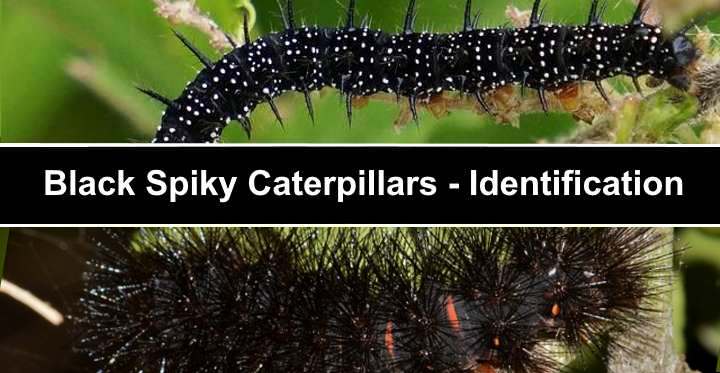
Black spiky caterpillars are unusual types of butterfly or moth larvae. The dark-colored, worm-like bugs can have a menacing appearance with their jet-black bodies, light or white markings, and fleshy spines or spikes on their body. Black caterpillars are typically not venomous despite their spikes because they don’t contain poison-filled spines.
The most common black spiky caterpillar with a spiny appearance is the great leopard moth caterpillar. This hairy black caterpillar is covered in tufts of stiff, smooth black spines. Other common black spiky caterpillars are the peacock caterpillar, black spiny elm caterpillar, and the red admiral caterpillar.
Most types of caterpillars are green caterpillars. However, you will also find species of fuzzy caterpillars, black and yellow caterpillars, and brown caterpillars. Compared to the thousands of caterpillar species, black caterpillars with spikes are the smallest category. In this list, you will find six species of spiky black caterpillars.
Are Black Spiky Caterpillars Venomous?
Most black caterpillars with spines or spikes are harmless to humans and don’t contain venom-filled tips. However, some black furry caterpillars may have fine hairs (setae) that can cause skin irritation.
Some black and spiky caterpillars like the mourning cloak and peacock caterpillar have barbed spines. Therefore picking them up could result in a stinging or burning sensation on your skin.
It’s generally best to avoid handling black spiky caterpillars, even though they don’t bite or sting.
How to Identify Black Spiky Caterpillars
Identifying black spiky caterpillars requires observing their size, type of spines, presence of hairs, and any particular markings. For example, some spiny black caterpillars can have a woolly bear appearance, and others look like spiky black slugs. You can also tell black caterpillars by their habitat or the type of plants they feed on.
Types of Black Spiky Caterpillars (With Pictures) – Identification Guide
Black spiky caterpillars are typically easy to identify due to their large, bristly spines. Additionally, their jet black or striped appearance stands out among green foliage, making black caterpillars easier to spot than green or brown caterpillars.
Giant Woolly Bear (Hypercompe scribonia)
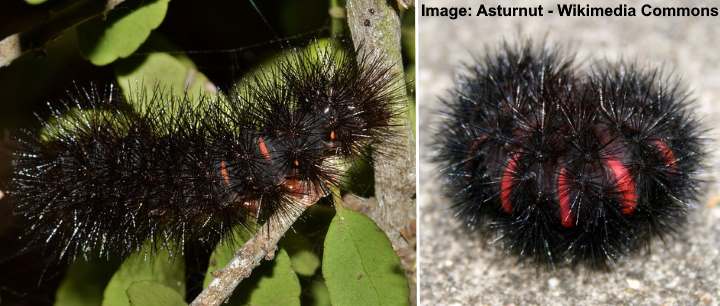
The giant woolly bear is black spiky caterpillar that also has red stripes between its black segments
Also called the giant leopard moth caterpillar, the giant woolly bear is a black spiky caterpillar with sharp, needle-like black spines. The black fuzzy caterpillar has identifiable red bands under the spiky covering that are visible when it curls up. The spiky black caterpillar measures 3” (75 mm) long.
The giant woolly bear has a recognizable characteristic of rolling into a ball when threatened. When the spiky black caterpillar does this, it reveals orange-red bands around its body. This action makes the caterpillar easy to recognize with its vibrant red stripes around its body.
The spines on the black leopard moth caterpillar are not venomous. However, despite the caterpillar’s fluffy appearance, the spikes are relatively sharp. These irritating hairs can cause a stinging sensation on the skin and leave behind a red rash. So, although a giant woolly bear is harmless, it is best to leave this spiky black bug alone.
The giant woolly bear caterpillar doesn’t start as a black spiky worm-like insect. Instead, during its first few stages, the short caterpillar is orange and black with sparse tufts of black setae (irritating hairs). When it matures, it grows into a black caterpillar covered in shiny, bristly setae.
After maturing from the pupa, the giant woolly bear turns into the great leopard moth. This spectacular white moth with black markings on its wings has an iridescent bluish-black body with orange markings.
Spiky black woolly bear caterpillars are found feeding on various woody plants, ornamental shrubs, and crops. You’ll find the fuzzy bugs on cabbages, citrus trees, willows, dandelions, sunflowers, and violets.
Black giant woolly bear caterpillars could be poisonous to other insects, birds, and predators. It is thought the chemicals they ingest from food plants create an unpalatable substance in their body. Also, their stiff, black spines act as a natural defense mechanism.
Black spiky caterpillar identification
The giant woolly bear caterpillar has a black body with red stripes and is covered in sharp black spikes. When the caterpillar rolls up to defend itself, the striking red bands appear between the dense tufts of black spikes.
- Adult Stage: The giant woolly bear caterpillar transforms into a beautiful moth known as the giant leopard moth (Hypercompe scribonia). The adult moth is striking, with its black-and-white spotted pattern on its wings.
- Host Plants: The giant woolly bear caterpillar feeds on a variety of plants, including dandelions, clover, violets, and other herbaceous vegetation.
- Habitat and Distribution: These caterpillars are commonly found in gardens, fields, meadows, and woodlands throughout North America.
- Stinging: The giant woolly bear caterpillar is not known to sting or cause skin irritation.
Peacock caterpillar (Aglais io)
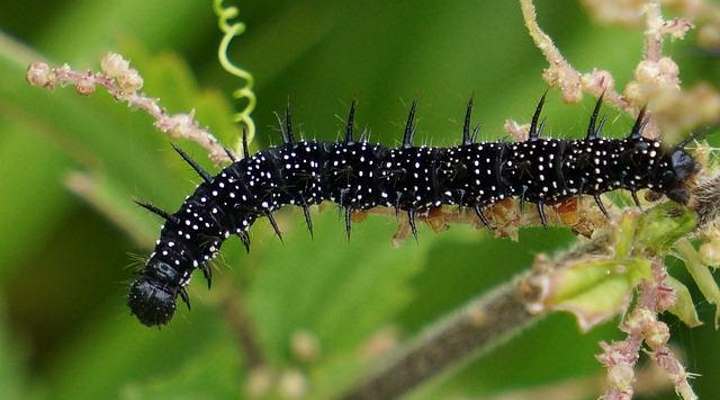
The peacock caterpillar can be identified by its black spikes and tiny white dots on its body
The peacock caterpillar is a shiny black worm-like caterpillar with white dots and barbed spikes covering its slender body. The black larva is easy to identify due to its six rows of spurs. This unusual black bug has a menacing appearance and measures around 1.5” (40 mm) long.
The soft-bodied crawling insect has a rounded black head and a jagged appearance. Despite the fact it looks dangerous, the black spiky caterpillar isn’t venomous. Its shiny, soft spines have tiny barbs on them. However, they are generally safe to handle and don’t sting or bite humans.
Peacock caterpillars feed exclusively on stinging nettles (Urtica). You can find masses of the spiked black caterpillars living communally in silken nests spun over the host plant.
After pupating, the peacock caterpillar morphs into a spectacular orange-brown butterfly. The identifying features of the beautiful, winged creature are large eyespots on its wings.
Black spiky caterpillar identification
The peacock caterpillar is identified by its shiny black body with white dots, rows of barbed spines, and rounded head. The spiky black caterpillar also has four pairs of tan-colored prolegs (false legs).
- Adult Stage: The peacock caterpillar matures into a beautiful butterfly known as the European peacock butterfly (Aglais io), featuring striking eye-like markings on its wings.
- Host Plants: The caterpillar primarily feeds on nettles, making them a common sight in areas where nettles grow.
- Habitat and Distribution: Peacock caterpillars are widespread throughout Europe and parts of Asia, typically found in gardens, meadows, and wooded areas.
- Stinging: Peacock caterpillars are harmless and do not possess stinging capabilities.
Black Spiny Elm Caterpillar / Mourning Cloak Caterpillar (Nymphalis antiopa)
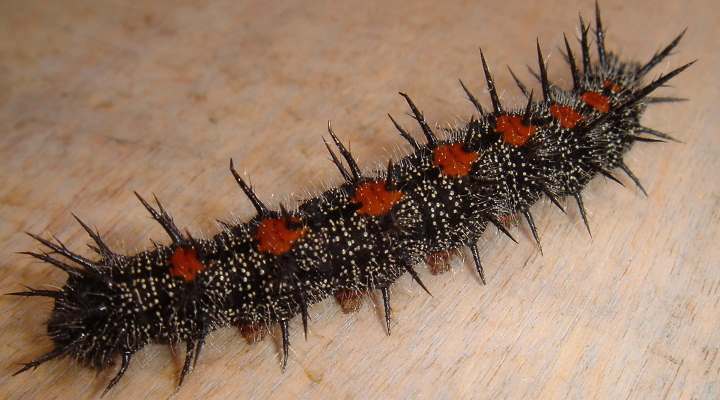
The spiky black elm caterpillar has orange-red markings and tiny white dots on its body
Also called the mourning cloak caterpillar, this spiny black caterpillar has a slender black body covered in black spikes and white dots. Additionally, there is a row of red-orange dots running along its back. The black caterpillar measures 1.5” (38 mm) long.
Apart from the line of dramatic red dots on its back, the spiny elm caterpillar is similar to the peacock caterpillar. Pictures of the caterpillar show its body covered in tiny white speckles and a band of barbed spines around each segment.
The spiny elm caterpillar isn’t a venomous black caterpillar and is harmless to humans. Due to the rows of jagged-looking spines, it could be easy to assume that the caterpillar is a stinging variety. However, this is not the case as the shiny black spines are relatively soft.
As the common name suggests, spiny elm caterpillars feed on elm tree foliage. However, the black bugs can also damage the leaves of poplar trees, willow trees, and birch trees.
After pupation, the spiny black caterpillar turns into a large brown butterfly with a striking yellow margin along its wing edges. You’ll also notice a row of iridescent blue spots lining its wings. The easily recognizable butterfly has unique markings and has the longest lifespan of any insect in the order Lepidoptera.
Black spiky caterpillar identification
The spiny elm caterpillar has identifiable reddish spots, white speckles, and fleshy black barbed spines covering its body.
- Adult Stage: The caterpillar transforms into the mourning cloak butterfly (Nymphalis antiopa), known for its dark wings with bright yellow margins.
- Host Plants: These caterpillars feed on various deciduous trees, such as willow, poplar, and elm.
- Habitat and Distribution: Mourning cloak caterpillars can be found in woodlands, forests, and gardens across North America, Europe, and Asia.
- Stinging: The caterpillars of the Mourning Cloak Butterfly are covered with urticating hairs that can cause skin irritation. While the caterpillar appears spiky and intimidating, its spines are not venomous and are primarily a defense mechanism against predators.
Red Admiral Caterpillar (Vanessa atalanta)
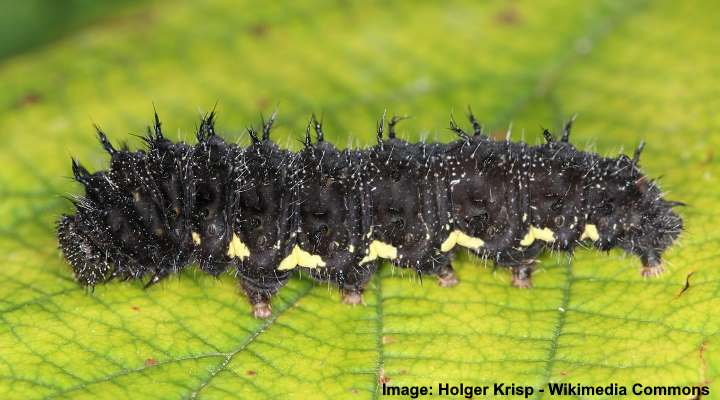
The red admiral caterpillar has black spiky body with tiny white dots and creamy-yellowish spots near its legs
The red admiral caterpillar is a black spiky caterpillar with a slender body covered in tiny white dots. The identifiable feature of this black caterpillar is its rows of fleshy spines giving the bug a spiky appearance. Black, red admiral caterpillars grow 1.4” (35 mm) long.
There can be some color variation between red admiral caterpillars. Some varieties are pale brown with a line of creamy-yellowish dots along their sides. In contrast, others are shiny black with black spiny spikes and a broken white stripe along their abdomens. Most caterpillars have a black head covered in short black spines and hairs.
Like most black caterpillars, the red admiral larva goes through several growth stages (instars). Immature caterpillars are long and slender with white speckles and spines. In its last instar, the caterpillar is a dark brown color with a plump appearance.
The harmless red admiral caterpillar feeds on stinging nettles and false nettles.
After emerging from the chrysalis, the once spiky black caterpillar is a beautiful brown butterfly. The medium-sized butterfly has black or dark brown wings with white spots and vibrant red bands.
Black spiky caterpillar identification
The red admiral caterpillar is an easily identifiable crawling insect with a slender black spiky body. Each segment of the black caterpillar features a transverse row of dark spines and a creamy white dot near its legs.
- Adult Stage: The red admiral caterpillar develops into the red admiral butterfly (Vanessa atalanta), which is recognized by its distinctive black wings with red-orange bands.
- Host Plants: These caterpillars primarily feed on plants from the nettle family.
- Habitat and Distribution: Red admiral caterpillars are found in various habitats, including gardens, meadows, and woodlands, and are widely distributed across North America and Europe.
- Stinging: The red admiral caterpillar is not known to sting or cause skin irritation.
Sweet Gale Moth Caterpillar (Acronicta euphorbiae)
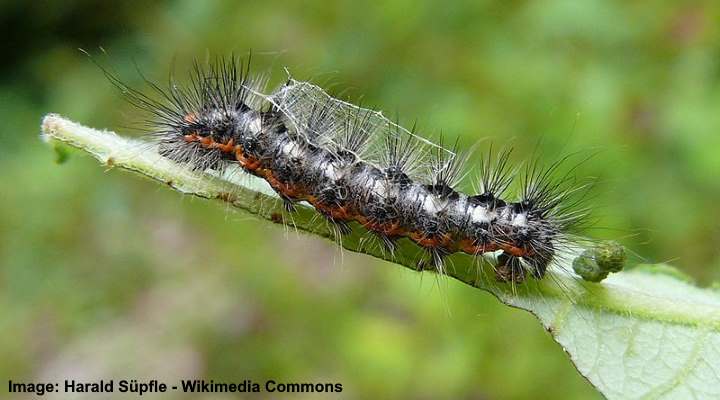
The sweet gale moth caterpillar has a black body with orange and white lines and black spiky bristles
The sweet gale moth caterpillar is a dark gray or black caterpillar covered in hairy spikes. In its early instars, the black hairy caterpillar has a slender black body, an orange band along its abdomen, and a grayish-white stripe along its back. The small caterpillar is covered in black tufts of thin spines.
The sweet gale moth caterpillar measures around 1.3” (33 mm) long when mature. After pupation, the once spiky black caterpillar has turned into a colorful fuzzy caterpillar. The caterpillar is orange, dark gray and white, covered in black-tipped yellowish setae. Through all instars, the caterpillar has a black head.
You may find sweet gale caterpillars feeding on yarrows, spurge, sorrel, and plantain plants during late spring and early summer.
After pupation, the colorful moth caterpillar turns into a furry brown moth with heavily mottled patterns on its forewings. Its slender hind wings are white, giving the moth an attractive appearance when in flight.
Black spiky caterpillar identification
The sweet gale moth caterpillar is black in its immature stage with an orange stripe along its sides and a pale gray band along its back. It is also covered in tufts of black spikes.
- Adult Stage: The sweet gale moth caterpillar matures into a colorful, fuzzy moth with brown mottled patterns on its forewings. Its slender hind wings are white.
- Host Plants: These caterpillars can be found feeding on yarrows, spurge, sorrel, and plantain plants during late spring and early summer.
- Habitat and Distribution: Sweet gale moth caterpillars can be spotted in gardens, meadows, and open woodlands, primarily in parts of North America.
- Stinging: The sweet gale moth caterpillar does not possess stinging capabilities and is not known to cause skin irritation.
Erasmia Pulchella
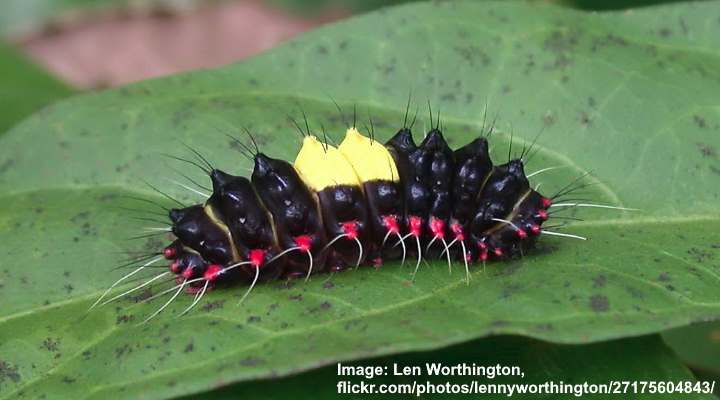
The Erasmia pulchella caterpillar has a shiny black body with yellow patch on the back, red dots on the sides and is covered with spikes
The Erasmia pulchella caterpillar is a large tropical spiky black caterpillar native to southeast Asia. The black caterpillar is covered in black hairs and has a recognizable yellow patch on its middle back. The shiny black caterpillar also has red growths and white spikes along the sides of its body.
Erasmia pulchella caterpillars have more of an oval shape rather than a slender, worm-like shape, typical of most spiky black caterpillars. The black, yellow, and red spiky caterpillar typically feeds on Helicia shrubs and plants common in southeast Asia.
Although not a venomous caterpillar, Erasmia pulchella emits a noxious hydride compound from its tubercles when disturbed. This foul-smelling substance acts as a natural defense mechanism against predators.
The Erasmia pulchella is a beautiful, multi-colored moth with black, bright white, deep red, and iridescent blue markings when emerging from the pupa. However, the vibrant coloration of the wings can change depending on the moth’s environment and climate.
Black spiky caterpillar identification
The Erasmia pulchella caterpillar is a shiny black caterpillar identified by its brightly colored yellow patch on its back, red growths along its abdomen, and black hairs emerging from tubercles.
- Adult Stage: Erasmia pulchella matures into a multi-colored moth with black, bright white, deep red, and iridescent blue markings. The coloration of the wings can vary depending on the moth’s environment and climate.
- Host Plants: These spiky black caterpillars feed on Helicia shrubs and plants common in southeast Asia.
- Habitat and Distribution: Erasmia pulchella caterpillars are native to southeast Asia, where they thrive in various tropical habitats and regions.
- Stinging: Although Erasmia pulchella is not a venomous caterpillar, it emits a noxious hydride compound from its tubercles when disturbed, serving as a natural defense mechanism against potential predators.
Pipevine Swallowtail Caterpillar (Battus philenor)
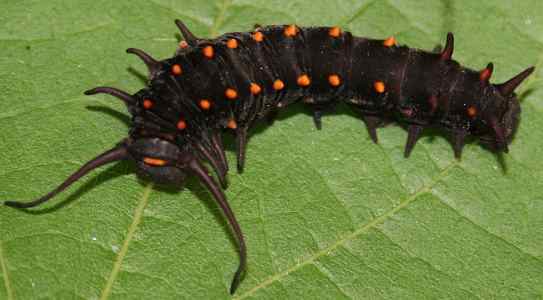
The pipevine swallowtail can be identified by its dark-brown or black body and orange spikes
The pipevine swallowtail caterpillar is a black, spiky caterpillar with fleshy horns (tubercles) at its head, tail, and sides. Along its back, two rows of bright orange or red dots add to its distinct appearance. The dark-colored caterpillar is covered in fine hairs, giving it a velvety texture.
These black and orange pipevine swallowtail caterpillars feed on pipevine plants commonly found in Florida, Texas, and California. Ingesting toxins from these plants makes them unappealing to birds and insects that might attempt to consume them.
While the orange and black spikes may appear threatening, this species of caterpillar does not sting humans. Instead, it relies on its vivid coloration as a warning signal, indicating to potential predators that it is distasteful or toxic.
The pipevine swallowtail caterpillar is not only an essential component of the ecosystem but also contributes to the natural beauty of the North American landscape with its unique appearance and role in the life cycle of the pipevine swallowtail butterfly.
- Adult Stage: The Battus philenor caterpillar matures into the pipevine swallowtail butterfly found in North and Central America. This butterfly has black wings with iridescent blue and orange spots on its hindwings.
- Host Plants: This caterpillar mainly feeds on plants belonging to the genus Aristolochia, commonly known as pipevines.
- Habitat and Distribution: The Battus philenor caterpillar can be found in various habitats, including open woodlands, meadows, gardens, and parks, where its host plants are prevalent. Its distribution spans across the eastern and southern regions of North America.
- Stinging: Battus philenor caterpillar doesn’t have stinging spines.
Related articles:
